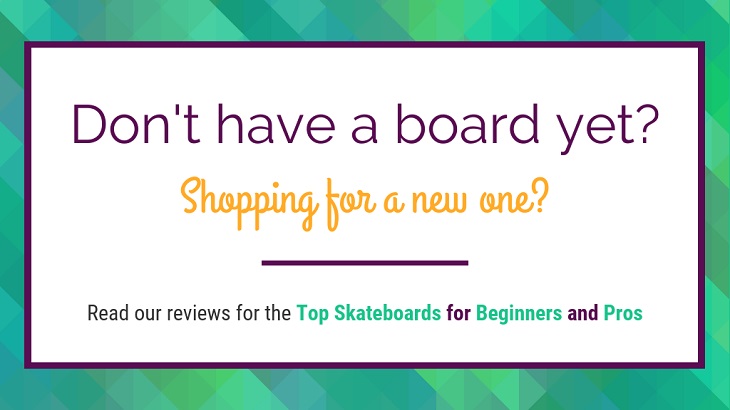So, you want to learn how to skateboard? There are some important things every skateboarder needs to know before stepping on the board for the first time. This post provides tips for beginners on how to skateboard without getting hurt.

“Hopefully, kids realize you can do anything you want. Skateboarding can be that gateway.”
- Ryan Sheckler, Professional Skateboarder -
You've decided that its time to give skateboarding a try, but how do you get started?
First of all, just like any other sport or recreational activity, skateboarding is something you actually have to get out and do if you are going to master it. No single article is going to teach you everything you need to learn. But there are some important tips and things you need to know before you step on the board for the first time — especially if you don't want to get hurt!
The goal of this article is to provide useful advice for beginners just learning how to ride a skateboard.
Once a sport associated with hard-core skaters who were usually younger, today more and more adults are turning to skateboarding either for a fun way to exercise, or as a means of transportation, especially in urban areas. Using a skateboard is faster than walking and provides more flexibility than riding a bicycle.
One of the beauties of skateboarding is that other than the basics, there is no right or wrong way to skate.
Yes, there are definitely things you need to know to keep you safe, but in the end, skateboarding is an individualized sport, with each person doing their own thing, and having their own style. This article isn’t going to teach you how to go from a beginner skateboarder to pro, but it will provide you with a good base of information to get started.
And because we know the importance of seeing things in action, it also includes some great videos collected from across the internet to illustrate the most important points.
Let's get shredding!
Who Invented Skateboarding?
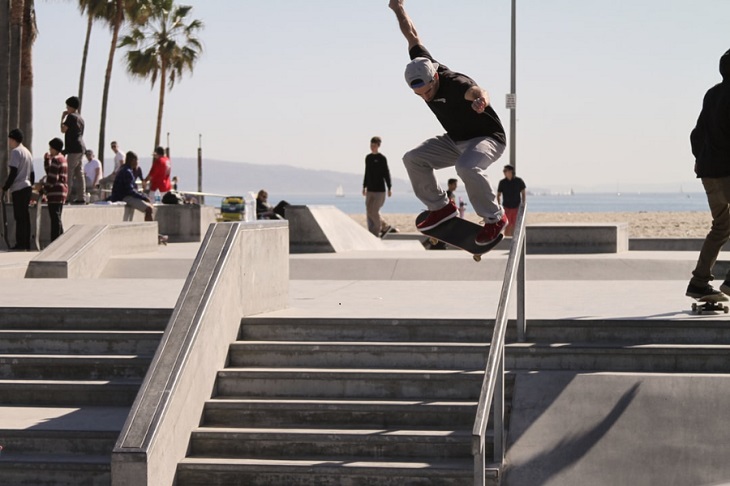
Before we get to the tips, let’s quickly cover the history of skateboarding and how it all got started.
When many people think of skateboarding, the first thing that comes to mind is all those fancy tricks and the “Skater” culture — which initially was tied to the world of surfing. But in recent years, it has become a popular means of transportation all around the world.
How and when did skateboarding start?
Skateboarding started out in California and Hawaii in the 1950’s and no one really knows who made the first skateboard. The story goes that there were “some” surfers who wanted to find a way to take their love of that sport and bring it to the streets. These early “asphalt surfers” took smaller boards or planks of woods and attached wheels from roller skates and thus the sport of “sidewalk surfing” was born.
Just like it’s hard to say who was the first person to come up with the idea, there are many differing stories about who sold the first commercially made boards on a small scale. What we do know is that a company called Roller Derby (you guessed it, a roller skate company) saw the potential and was the first to mass produce “Skate Boards” — all though there is debate on whether it was in 1959 or 1963.
It didn’t take long before local competitions started to take place, and in 1963 the first professional skateboard team (Makaha) was created and Hermosa, California held the first official skateboard competition.
Over the decades skateboarding has gone through some rough times, with ups and downs in popularity and skateboard companies coming and going (mostly because no one had perfected the board yet). And by the 1990’s, to “outsiders” skaters got a bad rep. This was partly due to the fact that many had become reckless, damaging things like benches, curbs, walls and steps. There was also a perceived connection between the rise of punk rock music and an “angry” skateboarder sub-culture.
Fast forward to today, and skateboarding is now one of the top 10 sports in the world, with a market share of $1.9 billion in 2018 with and forecast of 2.4 billion dollars by 2025.
And if that wasn’t enough to prove that skateboarding is now truly a sport in it’s own right, in 2016 it was announced that skateboarding will be an official sport at the 2020 Summer Olympics in Tokyo, Japan.
Things Every Skateboarder Needs to Know
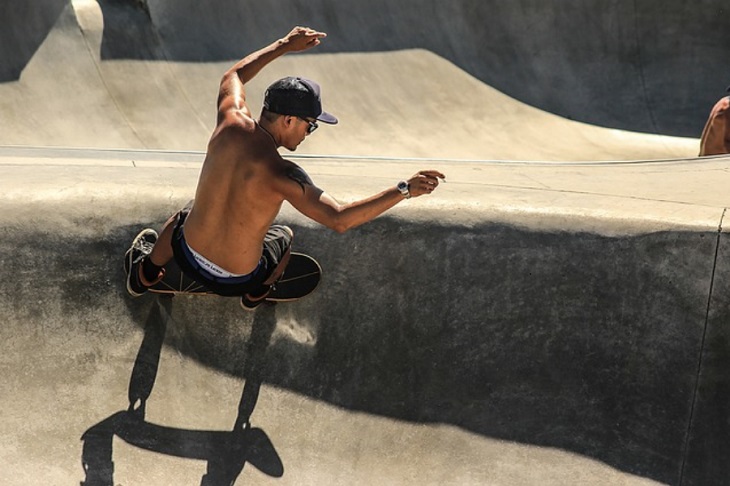
Tip 1: Choose a Suitable Board
There are a number of questions to be asked when it comes to purchasing your first skateboard. You may feel confused at the local skate shop because they sell a lot of different styles and brands of boards. While it may be tempting to get one of the best skateboards on the market, it’s better to take is slow — and that includes getting a “slower” skateboard.
If you are new, you don’t want to start with a skateboard that is designed for high speeds and doing fancy tricks, for a few reasons. First or all, these are more expensive, and you will want to make sure that skateboarding is a sport that you will truly enjoy before investing that kind of money.
Secondly, as a beginner it will take some time to get the hang of things. This means there is likely to be a few crash and burns. The last thing you want to do is spend a lot of money on a fancy board, only to damage it on your first day out.
Finally, as you are just learning how to skateboard, you want a board that matches your level of experience. Think of it this way: if you were just learning how to drive, would it make sense for your first car to be a Lamborghini or a Maserati?
When you are first starting out, you may not want a super-curved board but a flat one for easier balance. It will help you stay on the board without having to hold other things. Longboards are a good choice for beginners since, as the name suggests, they are longer so there is more foot room. You won’t be able to do as many fancy tricks with a long board, but they are easier to maneuver when just learning how to skate.
If you are someone who is interested in learning how to skateboard more for a means of transportation, you may want to consider getting an electric skateboard.
NOTE: Larger skateboard wheels roll faster, so when you are first starting out, you may want to go for smaller wheels. Softer wheels also tend to go slower, and they also grip the ground and absorb shocks better.
Now just because you aren’t going for a high-end skateboard for your first board, that doesn’t mean you should get a cheap board. A beginner skateboarder needs a quality board that is safe to ride. If you are purchasing a used board to learn on, make sure the wheels, trucks and bearings are in good working condition. You also want to make sure that there are no cracks or sharp edges and that the grip on the board is not worn.
Which brings us to the next tip for beginner skateboarders — protecting your body.
Tip 2: Wear Protective Gear When Skateboarding
If you have watched any professional skateboarding competitions, without a doubt you saw them wearing helmets, knee pads and elbow protection. But at the same time many experienced skaters don't wear helmets or gear and you will see tons of videos on YouTube without them.
Video: How to Fall When Skateboarding [Expert Advice from Pro Skater Aaron Kyro]
How to Fall Without Getting Hurt When Skateboarding (Plus Info about Protective Gear) | Courtesy of Braille Skateboarding
So, you may be wondering whether you need to wear a helmet when skateboarding?
First of all, don’t for a minute think, “Well I’m not going to be going that fast, or doing any tricks, so I don’t need all of that.” As a beginner, it’s actually more likely that you will fall.
While some states like California, New York, and Connecticut have laws that require children to wear skateboard helmets, as of this writing there currently no laws for adults — but it’s just good common sense to wear protective gear when skateboarding, especially if you are new.
Is skateboarding dangerous?
Research studies show that skateboarding as a whole is no more dangerous than most other sports. As a matter of fact, in terms of the chance of getting injured, it’s actually safer than many popular sports

The United States Consumer Product Safety Commission says that the number of skateboarding injuries is typically 8.9 per 1,000 participants, which is low. Basketball, a non-contact spot, has a 21.2 ER-treated injury per 1,000 players' rate. So, tossing yourself down a double set is technically safer than playing a game of H-O-R-S-E.”
- Sean Bowes in The Boardr, March 16, 2015 -
Interestingly, the number Sean quotes is actually lower than previous studies.
The 2002 Comprehensive Study of Sports Injuries in the U.S., done by American Sports Data, found 3.1 injuries per 100 study participants (2%) below what might be considered more “mainstream” sports — basketball (13.8%), running/jogging (8.2%) soccer (8.1%), football (5.4%), baseball (3.0%), recreational bicycling (2.2%), tennis (2.1%), and ice hockey (2.1 %).
The main safety issues come more from people who take more risks rather than from the sport itself. Another area of concern is with children because they have a higher center of gravity and less developed motor skills and balance, which makes them more likely to fall without proper training. Younger children also tend to be less aware of their surroundings, which increases the risk of collisions.
Another thing that these studies show is that proper protective gear, especially helmets, reduces the severity of injuries, and just like with snowboarding, increased usage is a contributing factor in the overall reduced injury numbers.
What are the most common skateboarding injuries?
The most common injuries associated with skateboarding are to the head, face, hands, wrists, shoulders and ankles. These range from minor scrapes and bruises, to sprains and breaks, all the way to potentially life-threatening concussions and traumatic brain injuries. Over 125,000 skateboarders sought emergency medical treatment in 2015, and it’s estimated that one-third of all emergency room visits for skateboarding injuries were brand new skaters with less than a week of experience. And 60 % of injuries involve children under the age of 15.
Another thing that these studies show is that proper protective gear, especially helmets, reduces the severity of injuries, just like it does for snowboarding.
Whether you are riding your skateboard for fun and tricks, or using it as a method of transportation, using protective will ensure your safety — especially if you are a beginner. A helmet can protect your head while knee pads, elbow pads and wrist guards can protect your arms and legs from injuries. Wearing the proper shoes also will reduce the chance of falls.
Tip 3: Wear a Pair of Good Skate Shoes
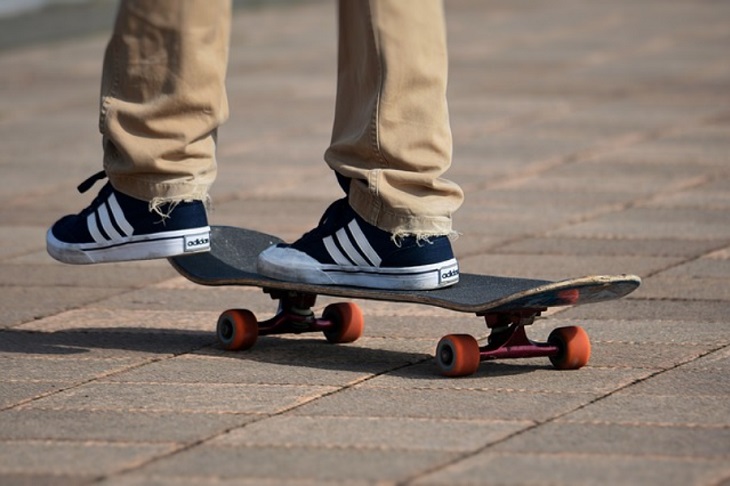
Believe it or not, the first skateboarders, because most of them were surfers, actually skated barefoot. Needless to say, this contributed to a lot more accidents.
Choosing the right shoes is necessary for any sports and skateboarding is no exception. If you wear flip-flops or combat boots to skate, you are likely to get hurt. Therefore, getting a pair of skate shoes is one of the most important things to do for your first skateboarding. You can buy shoes like Etnies, Vans, DC’s, Nike SB, or Adidas as they are able to ensure both support and protection for your feet as well as your whole body.
If you are not ready to purchase shoes designed for skateboarding, make sure you are wearing shoes with a flat bottom and a good sole that will grip the board.
Tip 4: Learn How to Fall On a Skateboard
This tip may seem kind of backwards. Shouldn’t you be learning how NOT to fall?
Well, yes and no. Obviously the end goal is to be able to stay up straight on your board, but no matter how good you become, there will be falls.
The trick is to learn how to fall in a way that decreases the chance of serious injury. When we are about to fall, the natural instinct is to brace ourselves for impact. Our bodies become stiff, and a there is a tendency to hold our arms straight out to try to stop from hitting the ground. In reality, this actually has the risk of making things worse, especially when moving at higher speeds on a skateboard.
For example, there is more chance of sprained or broken wrists when you hold your arms out straight — your hands bear the full impact of the fall, instead of it being dispersed throughout the body.
Video: How to Fall Without Getting Hurt on a Skateboard [Tips from Pro Skater Nigel Alexander]
How to Fall Correctly in Skateboarding | Courtesy of Braille Skateboarding
In order to reduce major injuries, you actually need to learn how to relax when you are about to fall. You want to learn how to roll into the fall, trying to land on the softer, more fleshy parts of your body. You also want to learn how to break the instinct of reaching out with your arms, instead bringing them to your body and tuck your chin in.
This is not going to come naturally, so you should actually practice falling on the grass or other soft surfaces. Not only is this a good skill for skateboarding, but it’s one that will be useful in all areas of your life.
If you don’t learn how to fall safely, not only will you get hurt, but you are more likely to give up on skateboarding!
Tip 5: Find a Good (and Safe) Place to Skate
It is obvious that you cannot skate wherever you want because it is dangerous not only for yourself but also for people around you. As a consequence, you have to find a suitable place like a skate park in your neighborhood to try to learn how to skate.
If there is no official place to skate in your town, then you will have to find other alternatives. These places need to be flat and even so that you may be safe during your practice. In addition, you can also avoid want to bumps and cracks that can ruin the skateboard, but more importantly are hazards for newbie skaters..
When skateboarding, it’s important to pay attention to weather conditions.
Make sure to avoid wet areas and ensure that the deck of your board and shoes stay dry. Avoid areas with fallen leaves and twigs, and watch for icy roads and black ice.
Skateboarding is a fun way to burn calories and have a great time — and it's never to late to start!
It’s also important to obey local laws about where you are allowed to skate, and where you can’t. Often, there will be signs posted if it’s prohibited, but don’t count on that if you don’t want to get ticketed.
One of the best ways to find good areas to skateboard is to ask other skaters. If you don’t know anyone, turn to social media for your local area. There are also apps such as Skate You, Skate Spots and Shreddit — which not only provide information about places to skateboard near you, but also have other information about skateboarding.
When you are first learning, avoid crowded areas, but don’t skate alone. In case of an accident, you do want someone around to get help if needed.
Tip 6: Ask a Skater to Skate With You
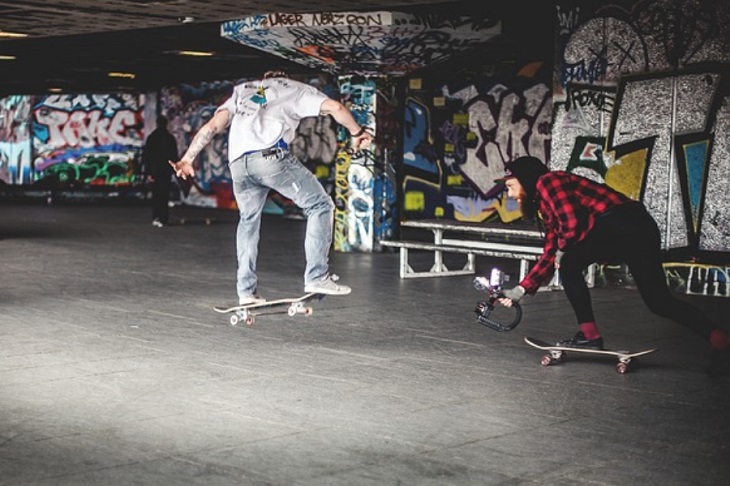
It is easier for you to learn how to skate if you have someone to skate with you.
You are also less likely to feel embarrassed when you have the support of peers cheering you on. They have been where you are, and most are eager to help.
People who are experienced in skateboarding will watch and help you improve your skills and tricks to use during your practice. They will give you helpful advice from their experience to help you skate better.
However, trying to go out with a lot of people Ollie'ing down a flight of stairs is not the way you want to go.
Having someone to teach you the first steps is a great way to prevent serious mistakes and avoid picking up bad habits which are hard to fix afterwards.
You need to find someone willing to go at your pace, otherwise you hurt yourself trying to keep up with them. You also don’t want to interrupt their fun by asking for help when they are in the middle of doing their tricks. Instead, ask if they would be willing to give you a hand when they are finished. Then, stay out of their way. Proper skate etiquette and common courtesy goes a long way.
Choose the right person to go out with and go slowly. With practice, you will be ready to skate by yourself.
Here's another great idea. Have the other person record you while you are skating so you can discuss what you did right and what could be improved.
Tip 7: Watch Tutorial Videos About Skateboarding
As mentioned before, skateboarding is not something you can learn from just reading. Yes, you can pick up tips from articles, books and apps.
But besides actually getting out there and doing it, watching others is one of the best ways to learn, particularly when it comes to more advanced tricks.
Video: How to not look like a beginner skater [Tips from Pro Skater Justin Lauria]
15 Things that Make You Look Like a Beginner Skater (and How Not To) with Justin Lauria | Courtesy of NSI Skateboarding
While it would be best to watch people in person so you can ask questions, not everyone has that option. However, with the internet there is a ton of information out there.
You may make a lot of mistakes at your first try, so try to watch compilation videos and tutorials to learn useful tips and tricks. There are also apps specifically for skateboarders that are jam-packed with info.
Best Videos to Learn How to Skateboard and How to Do Skateboard Tricks
Some YouTubers who have good information about skateboarding include Andy Schrock or Aaron Kyro. Here are some other good resources and channels (in no particular order):
Tip 8: Practice Makes Perfect
It might be very difficult when you first try to skate. But you need to keep on skating until you can stay on the board. Depending upon your natural abilities, it may take you a bit of time and effort.
But just like learning anything now, if you quit you are not able to do anything.
Video: 5 Skateboard Tricks for Beginners [Tips from Expert Skater Aaron Kyro}
The 5 Easiest Skateboard Tricks for Beginners [Even Easier than and Ollie] | Courtesy of The Braille Skateboarding
Just take it slowly, practicing as much as you can, and you will be more confident and improve your skills. Try to avoid discouraged comments from other people.
Stay focused on what it is you want to achieve.
Tip 9: Only Do Tricks When You Are Ready
So, you’ve been watching those pro skateboarding videos and can’t wait to do your first 360, Gazelle Flip, Nollie Flip or even a 180.
Not so fast grasshopper…
Video: 10 Easy Skateboard Tricks for Beginners
10 Easy Beginner Skateboard Tricks | Courtesy of VLSkate
The first thing to do for beginners is to stay balanced on the board. You have to keep doing this until you feel comfortable without regularly falling down. Once you can control the board, it is the right time for you to try some tricks. The best and easiest tricks for beginners include shove-it, grinding, Ollie or kick-flip.
When you master those, then take it one step at a time adding to your arsenal of tricks. If possible, this is a great time to get the help of someone who already knows how to do the tricks.
A Few Final Words...


“Skateboarding teaches you how to take a fall properly. If you try to kickflip down some stairs, it might take you thirty tries – and you just learn how to take a tumble out of it without getting hurt.”
- Brandon Margera, American Pro Skateboarder -
With the right mindset and practice, you can learn how to skate like a pro.
Whether you are looking to master the hardest tricks around, or are just looking for a cool recreational activity, skateboarding is great exercise for all ages.
Traditionally skateboarding has been more of a guys sport, but the number of girls getting involved is increasing, including professional female skateboarders. Due to this increase in popularity, there are many brands are now making skateboards designed with girls in mind.
Even if you never end up being a core skater, diving full on into the culture, being a casual skater is still lots of fun.
Remember, if you need a board, check out this article:
And just because learning how to properly fall on a skateboard without getting hurt is so important, we’ll leave you with one last video — this time from the world of Parkour.
Video: How to Use Parkour Rolls to Fall on on a Skateboard [Pro Advice from Ronnie Shalvis]
Parkour Safety Rolls Tutorial - Forward Roll, Side Roll, Back Roll | Courtesy of Ronnie Street Stunts

